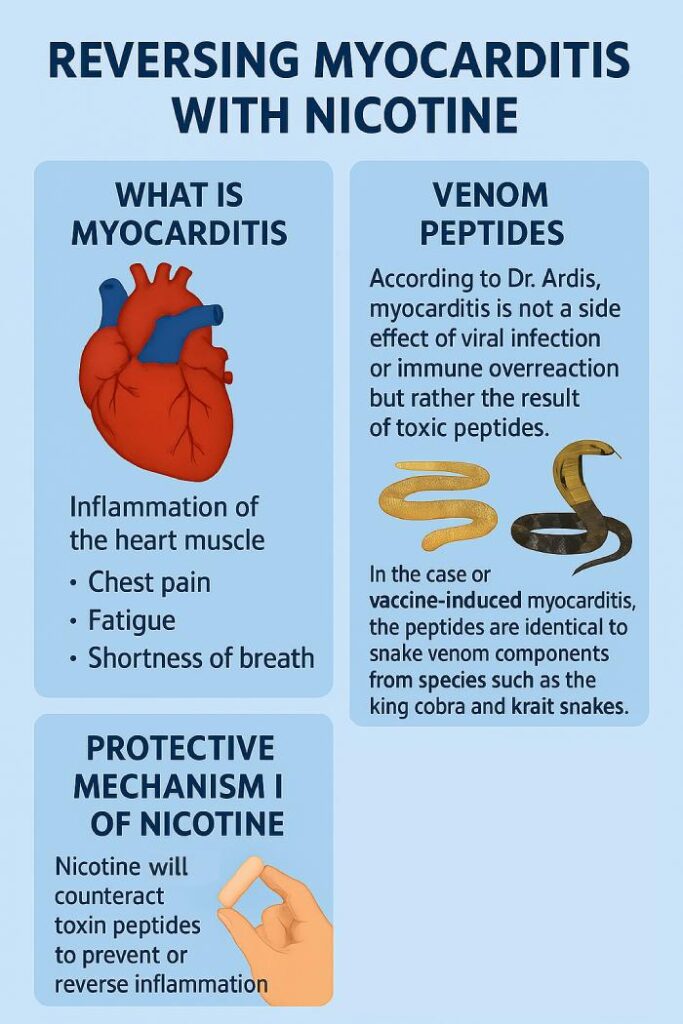
Dr. Bryan Ardis: Reversing Myocarditis with Nicotine
Dr. Bryan Ardis believes that various diseases — including myocarditis — are caused by venom peptides and that nicotine can act as an antidote. He says that specific types of toxic peptides, not viruses or bacteria, are the root cause of many modern illnesses.

Venom Peptides and the Root Cause of Myocarditis
According to Dr. Ardis, myocarditis is not a side effect of viral infection or immune overreaction but rather the result of toxic peptides. In the case of vaccine-induced myocarditis the peptides are identical to snake venom components from species such as the king cobra and krait snakes.
These peptides have been identified in the blood, urine, and feces of COVID-19 patients and vaccine recipients. They bind to ACE2 receptors and nicotinic acetylcholine receptors (nAChRs) throughout the body, including the heart, and disrupt normal function. This leads to inflammation, clotting, and tissue damage, which he identifies as the true mechanism behind myocarditis.
He emphasizes that these peptides are neurotoxic and cardiotoxic and may reach the body through environmental exposure, the bloodstream, or even be introduced via pharmaceutical products.

Nicotine as an Antidote
Nicotine has the ability to block venom peptides from binding to key receptors in the human body. He explains that nicotine binds to nAChRs – the same way the Ivermectin does – acting as a protective agent that occupies the receptors before venom peptides can attach.
He further links this concept to observational studies from early in the COVID-19 pandemic, in which smokers were found to have lower rates of hospitalization and mortality. He believes this protective effect was not due to tobacco smoke, but to nicotine itself.
This theory forms the foundation of his proposed therapeutic use of nicotine, not for recreational use or addiction, but as a targeted protocol to reverse venom-related symptoms, especially those affecting the heart and nervous system.
Suggested Forms of Nicotine
To avoid the harmful chemicals found in commercial cigarettes, Dr. Ardis recommends:
- Nicotine gum (commonly 2 or 4mg per piece)
- Nicotine patches
- Nicotine lozenges
- Organic, additive-free tobacco (used consciously, not recreationally)
He discourages the use of conventional tobacco products due to their toxic additives, focusing instead on clean, controlled nicotine sources.

Nicotine Dosage Recommendations
Dr. Ardis discusses two approaches to nicotine dosing:
Standard Protocol
Ardis mentions that as little as a 2 mg nicotine gum dosage, taken three times per day — morning, afternoon, and evening can help with many health issues. He reports that many people who followed this simple regimen experienced rapid relief from symptoms, in some cases within 15 to 30 minutes of taking their first dose.
Weight-Based Dosing for Serious Illness
For myocarditis and more serious disease, Dr. Ardis refers to a French study where nicotine dosage was determined by body weight. He explains that the dosing used in this study was 0.2 mg of nicotine per 2.2 pounds (1 kilogram) of body weight per day. This amount should be divided throughout the day, using either nicotine patches, gum, or lozenges.
Based on this formula, the daily nicotine requirement would be:
- A person weighing 10 kg (22 lbs) would require 2 mg of nicotine per day
- A person weighing 50 kg (110 lbs) would require 10 mg of nicotine per day
- A person weighing 60 kg (132 lbs) would require 12 mg of nicotine per day
- A person weighing 70 kg (154 lbs) would require 14 mg of nicotine per day
- A person weighing 80 kg (176 lbs) would require 16 mg of nicotine per day
- A person weighing 90 kg (198 lbs) would require 18 mg of nicotine per day
He highlights that this level of dosing is significantly higher than the common 6 mg/day (2 mg taken three times daily), and that many people may not be using enough to fully occupy the nicotinic receptors and prevent venom peptide activity. He encourages those with myocarditis following the protocol to consider their body-weight when choosing a nicotine dose and to maintain a consistent intake throughout the day.
Reported Results from Nicotine Use
Dr. Ardis shares multiple reports of people experiencing improvements in their conditions after beginning nicotine therapy. Some of the key results he mentions include:
- Reduction in chest pain and other myocarditis symptoms
- Improved energy and breathing
- Cessation of tremors or seizures
- Relief from long COVID symptoms
He claims that in certain cases, symptom relief occurred within minutes, especially when nicotine gum was used.

Other Conditions Dr. Ardis Says Will Respond to Nicotine Therapy
While myocarditis is his central focus, Dr. Ardis expands the scope of his claims to include a wide variety of conditions. He suggests that all of the following may be linked to venom toxicity and may respond to nicotine therapy:
- Myocarditis
- Pericarditis
- Blood clotting disorders
- Tremors
- Seizures
- ALS-like symptoms
- Facial paralysis or drooping
- Long COVID
- Vaccine-related injuries
- Cognitive issues and brain fog
- Respiratory paralysis
- Fatigue and weakness
- Parkinson’s-like symptoms
- Chronic inflammation
In each case, he attributes the underlying dysfunction to venom peptides interfering with cellular signaling or receptor function. Nicotine, by his explanation, offers a direct countermeasure by preoccupying those same receptors.
Mechanism Summary
- Venom peptides bind to ACE2 and nicotinic acetylcholine receptors, disrupting heart, brain, and lung function
- Nicotine (also Ivermectin and HCQ) binds to those receptors first, preventing venom peptide attachment
- This binding effect reverses or blocks symptoms, particularly when the peptides are the root cause of the illness

How Long Should You Use the Protocol?
Dr. Ardis does not provide a formal treatment timeline but notes that symptoms may return if nicotine is stopped too early. He suggests maintaining usage as long as symptoms persist and tapering off gradually.
